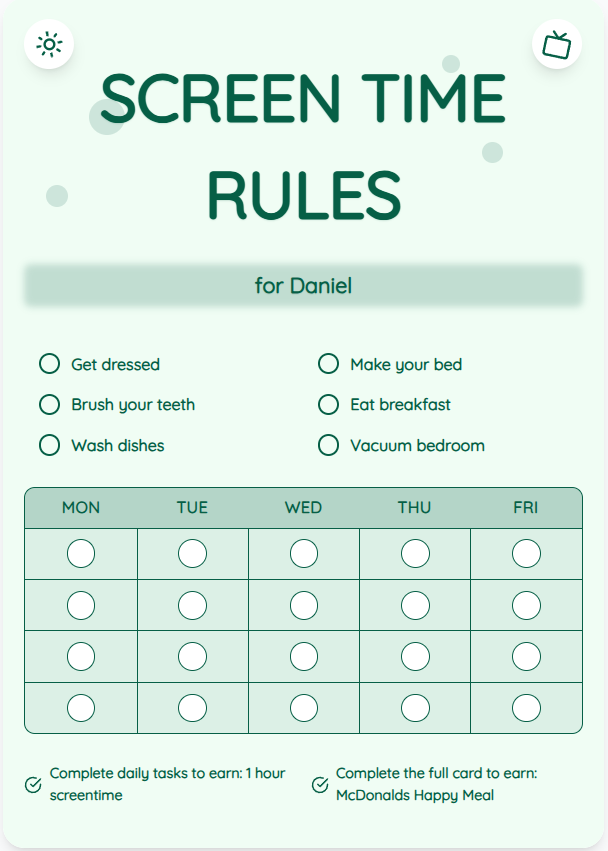Screen Time Guidelines for Young Children: A Parent's Comprehensive Guide
As a parent, navigating the world of screen time for young children can be challenging. Finding the right balance between educational content and excessive screen exposure is crucial for your child's well-being. In this guide, we provide expert advice and actionable tips to help you establish healthy screen time guidelines for children aged 2-12.
See What Your Screen Time Chart Will Look Like
Here's an example of a beautiful, customizable screen time rules chart you can create for your family

Understanding the Impact of Screen Time on Young Children
Young children's developing brains are highly sensitive to screen time. Excessive use of screens can impact their cognitive development, social skills, and physical health. It's essential to be mindful of the content and duration of screen exposure to support your child's overall growth and well-being.
Setting Effective Screen Time Limits
Establishing clear screen time limits is key to managing your child's screen usage. Create a daily screen time schedule that includes a healthy balance of interactive activities, outdoor play, and educational screen time. Consistency and communication are vital in enforcing these limits.
Put These Tips Into Action
Create a custom chart to implement these strategies with your child
Choosing Quality Screen Time Content
Not all screen time is created equal. Opt for educational apps, games, and shows that promote learning and creativity. Utilize screen time charts to track your child's usage and ensure they are engaging with age-appropriate, enriching content.
Promoting Alternative Activities
Encourage your child to participate in non-screen activities such as reading, arts and crafts, sports, and family bonding time. Limiting screen time opens up opportunities for your child to explore new interests and develop essential skills outside the digital realm.
Practical Tips for Success
- Create a designated screen-free zone in your home.
- Involve your child in setting screen time rules to promote ownership.
- Use positive reinforcement to reward adherence to screen time limits.
- Model healthy screen habits by limiting your own screen use in front of your child.
Frequently Asked Questions
How much screen time is appropriate for young children?
The American Academy of Pediatrics recommends no more than 1 hour of high-quality screen time per day for children aged 2-5. For children aged 6-12, consistent limits should be set based on individual needs and activities.
Are there benefits to using screen time charts?
Screen time charts help parents track and manage their child's screen usage effectively. By visualizing screen time limits and content choices, charts serve as a useful tool in promoting healthy screen habits.
How can I handle resistance to screen time limits?
Communicate openly with your child about the reasons behind screen time limits. Offer alternative activities and incentives to encourage compliance. Consistent enforcement and positive reinforcement can help address resistance over time.
What are signs of excessive screen time in young children?
Signs of excessive screen time include irritability, difficulty concentrating, disrupted sleep patterns, and lack of interest in non-screen activities. Monitoring your child's behavior and mood can help identify the effects of prolonged screen exposure.
By implementing these practical strategies and guidelines, you can create a balanced approach to screen time that supports your child's development and fosters family harmony. Remember, moderation is key in navigating the digital landscape with your young children.
Ready to Transform Your Family's Screen Time?
Join thousands of parents who have successfully managed screen time with our customizable charts.
